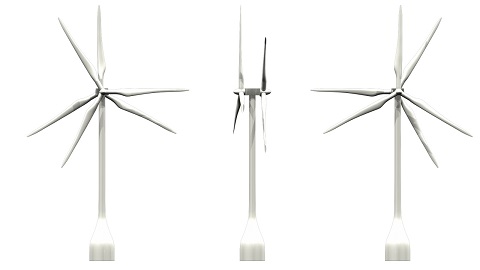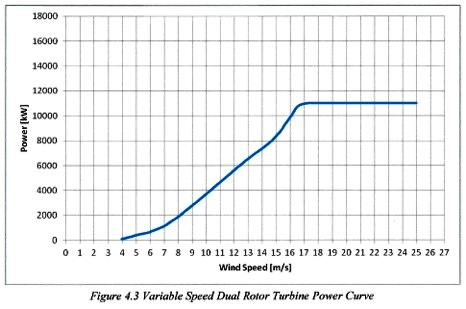
The upwind, side, and down wind views are of the 11 MW Airgenesis. The rotors are offset 30 degrees.
About a year ago this magazine reported on the design completion for a twin-rotor turbine that its developer boasted was capable of generating 11 MW. The Airgenesis turbine (airgenesiswind.com) sports other innovations, such as using a shaft to transmit power down tower to several generators arranged in a circle at the tower base. Twelve generators, two 500 kW units and 10 rated for 1 MW each, will let the turbine begin generating power in usually unproductive 3 m/s winds. Airgenesis spokesman Clayton Troxell recently provided an update on the project.
“We’re making good progress in that we’ve completed more testing on the digital prototype by aerospace engineering firm DARcorp,” says Troxell. “From their simulations, we found that best clock angle for the blades is a 30° separation, not 60°. It turns out that 30° lets the wake from the front rotor more often miss the aft rotor, allowing a 92% yield.” The company originally thought that low rpms would be good for aft rotor, but simulations showed that increasing the rotor speed to about 15 to 20.6 rpm achieved a higher electrical production and at the same time reduced the torque on the entire drive train, and in turn, reducing the size of the gearing.
Troxell says DAR conducted about two weeks of tests on its supercomputer to confirm previous expectations and explore other possibilities. For instance, it found that output could be bumped to 16 MW if they used blades larger than the planned 48m blade provided by NREL/NWTC Informational Portal.
“We are capable of producing electrical power at lower wind speeds because of a variable speed 500-kW generator at the base that begins producing power in lower winds. The power curves produced by DARcorp show power production starting at 4 m/s because that is when 15 rpm on the blades are possible. Also, the designs should handle higher winds that would shut down conventional turbines. For the time being, we will say 11 MW is tops,” Troxell adds.
He also says the design is headed to prototyping. It will take a year to build the 11-MW prototype and Airgenesis expects it to fly in 2014. “All manufacturers are in line and the tower guys are ready to go,” he says.
Filed Under: News, Turbines






you can run up to six sets of blades .power extraction runs much closer to the betz limit and stresses on the tower are much reduced . think of a bike wheel spinning while you hold the axle ,but here the two (wheels cancel each other also multi rotor generators as in ship propulsion can utilize the extra power produced . it woks incredibly well .
What is the difference with have, simply, a 6 blades rotor?
Pretty good idea !!